by Jean-Baptiste De Vaulx
Watch the ViewFinder BoB Playlist for this essay
Multiple Perceptions of the Domestic in Lucrecia Martel’s Salta Trilogy
During the past months, Blaise Pascal’s claim that all mankind’s problems stem from an inability to sit quietly at home may have seemed truer than ever for many of us. While we have been feeling the strain of staying in, one way out of Pascal’s quandary might have been to catch up on our to-watch lists. Perhaps appropriately watching something that gives a new sense of perspective and possibility to our perception of the domestic sphere we find ourselves spending more time in. In this article, I wish to argue that not one but three films, the so-called Salta trilogy, by the visionary Argentine filmmaker Lucrecia Martel, achieve exactly that. They offer us the opportunity to challenge the way we view home as setting and as social realm, notably through two main strategies: letting us perceive what is repressed and excluded within the home, and encouraging us to perceive the home from estranged, unconventional perspectives.
The three films in the Salta trilogy, are set in Martel’s home province of Salta in northern Argentina and tell quite different stories. La ciénaga (2001) chronicles a few days in the lives of two branches of an extended family, respectively headed by two matriarchs, Mecha and Tali, both of whom remain oblivious to the sense of impending tragedy that pervades the film. In The Holy Girl (La niña santa, 2004), the setting is a hotel owned by divorced mother Helena, who lives on the premises with her teenage daughter Amalia. On the week of a medical convention taking place at the hotel, both mother and daughter become independently involved with Dr Jano, one of the attendees; the mother hoping to have an affair with him, and the daughter confused into a simultaneous sexual and spiritual awakening after Jano molests her in the street. Finally, in The Headless Woman (La mujer sin cabeza, 2008), Veronica, a middle-aged mother and wife, believes she has accidentally run over a child but chooses to ignore and suppress her guilt, letting others around her deal with the consequences of the incident.
Perceiving What is Repressed at Home
The most obvious common point across the three films is family, and all families in the Salta trilogy share a certain complacency in their vision of homes as safe shelters. Rather than confronting the problems in their homes, they remain oblivious or choose to ignore them. Visually, the films translate this by shooting domestic interiors in dim natural light, as dusky self-enclosed settings lacking in both light and air. Within these walls characters wrongly assume they are safe: Tali in La ciénaga spends most of her time passing judgment on Mecha’s family but it is eventually in her own home that tragedy strikes; in The Headless Woman when Veronica first returns home after the car accident, she closes the blinds and attempts to sleep in the middle of the day but her paranoia and guilt continue to fester, even in this supposedly safe place, since they are already rooted in her mind. In The Holy Girl both Helena and Amalia remain unaware of each other’s respective associations with Dr Jano, which are set for a calamitous collision course in the hotel they call home.
Home in these instances functions as a hermetically sealed cocoon (or the illusion of one), closed in on itself to the point of suffocation. Martel represents this by overfilling her images with people, in both foreground and background, creating a permanent claustrophobia (see pictures below). Her characters hope to be alone, locked in their rooms and sleeping the days away, but in truth they never can escape the gaze and presence of others.
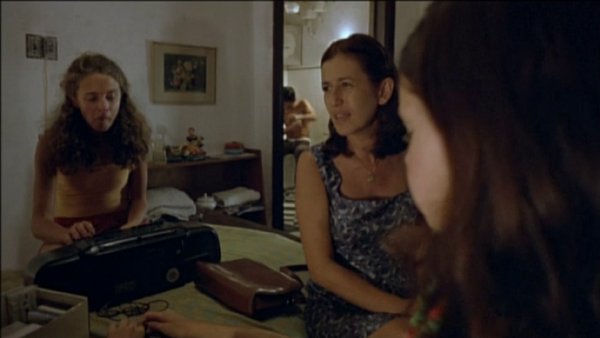
La ciénaga, (2001)
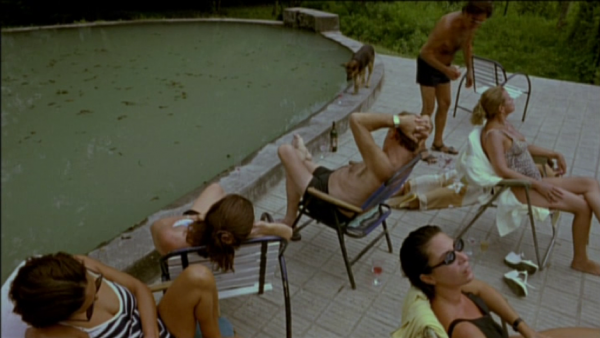
La ciénaga: Martel overfills her images with people; in the second shot here, for example, we may initially miss Mecha’s legs on the floor after her fall, as all her guests seem to ignore her.
Likewise, attempts to shut out worries from outside the home are undermined through Martel’s use of sound, which can pierce through the supposed safety of the homes. In La ciénaga, distant hunting gunshots reverberate ominously into Mecha’s home, while it is the barking of the neighbour’s dog which fatefully triggers the confused terror of Tali’s young son. In The Holy Girl, the same musical instrument played during Jano’s molestation of Amalia (a street player’s theremin) enters the hotel as if to symbolically announce the bad vibes are not going away. Veronica, in The Headless Woman, is haunted by sounds: the thud she thinks was her car hitting a child, or her relatives disturbing her attempts to sleep off her troubles. The shelter promised by the home is only tenuous and breached by sounds which continue to echo within the characters’ psyches.
Home may present the illusion of shelter, but for it to be sealed off means it shuts certain people out. In all three films, indigenous characters working in the homes are relegated by the family to the periphery. In The Headless Woman, Veronica’s cousin whispers “Don’t let them in” to her daughter when indigenous girls delivering flowers ring the doorbell (see picture below), as if they would somehow contaminate the home by entering. In La ciénaga, there are moments of togetherness among Mecha’s dysfunctional family – for instance, the impromptu dance triggered by the clowning of the eldest son, a genuinely happy moment. But these never include the indigenous domestic workers whom Mecha constantly berates or accuses, despite relying on them so much.
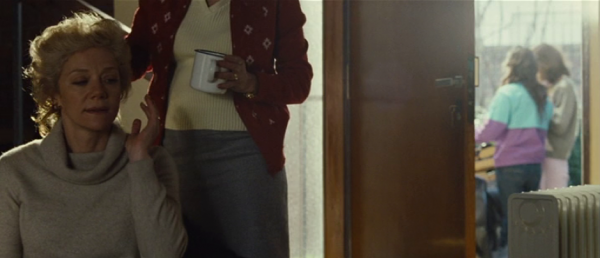
The Headless Woman: In a visual representation of those excluded from the home, we glimpse the indigenous girls on the extreme right of the frame outside the house.
The marginalisation of the domestic workers from the very homes they keep running is a truth Martel prods us into realising, not by making it obvious, but by engaging our perceptive skills through the visual strategy of having the servants constantly somewhere in the frame, maybe out of focus or in the background. They may be taken for granted by the families in the films, but we are urged to see them and judge for ourselves. Home thus works as wider metaphor for attempts to repress external problems: the stratification of society into castes (domestic workers are shut out despite being integral to the home and family) and the normalisation of racism (children come to repeat the hateful clichés they hear from their elders), only cementing the exclusory and self-enclosed nature of these homes.
Revitalising the Gaze on the Home
Alongside this desire to make us see what goes unseen in the home, Martel’s films also offer us the chance to see it through a new gaze, revitalising a setting not typically considered cinematic. For example, in The Holy Girl, Martel chooses to make a hotel be the home of Helena and Amalia, even though there is something not quite home-like about the continual flow of guests through a hotel. In that film, the hotel becomes an estranged version of the home. This idea is verbalised by a character in the film, the mother of Amalia’s best friend, who reprimands one of her sons for only coming home at mealtimes: “This isn’t a hotel, it’s a family home,” she tells him. But is the hotel Amalia has grown up in not a home then?
One useful reference point in dealing with the home as a place is Yi-fu Tian’s classic study of human geography Space and Place, first published in 1977. In it, Tian defines ‘place’ as embodying stability and security, somewhere we settle and call a dwelling. On the other hand, a ‘space’ is associated with freedom and potential, somewhere we temporarily move through. Helena’s hotel is a ‘place’ for Amalia who has known it all her life. But for Jano and the other doctors, it is a ‘space’, somewhere to stay and leave again after a few days, allowing them to get away from their lives (and wives) back home. The hotel is thus a double-edged setting, both place and space at the same time, the perfect means for Martel to explore a multiplicity of co-existing perspectives.
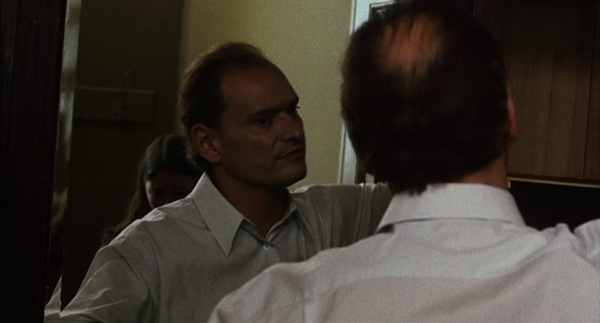
The Holy Girl: Amalia’s ‘home advantage’ is clear when she appears, almost out of nowhere, behind Dr Jano.
While Jano is lured into a false sense of freedom by the space of the hotel, Amalia turns the tables on him thanks to her literal home advantage. She spies on the doctor, entering his room without him noticing, much to his increasingly disoriented bafflement. In one scene, Amalia suddenly appears in Jano’s room, creeping behind him in the mirror (see picture above). In this place that may seem so un-homely to others, she is entirely at home, able to appear from anywhere, almost as if she can walk through the hotel’s walls like a ghost.
This metaphorical ability might sum up all the Salta trilogy films, in which there is a constant blurring of divisions. It’s not just that a character like Amalia seems to have the porous ability to walk through walls or that sounds from outside can pierce into the home. Everything in Martel’s films has this same kind of fluidity across boundaries. Sounds from outside the home, and outside the frame, enter and blur the distinction between inside and outside. Relationships between characters are ambiguous and we constantly must re-think what we thought we knew about who is who, as if relations within the home are interchangeable. Time itself seems to be unclear; in both The Holy Girl and The Headless Woman characters close curtains or blinds, creating a suspended sense of time in which we cannot even be sure whether it is night or day.
This fluidity allows home to be many things in these three films. Martel’s treatment of the subjectivity of perception (each of her characters has a different perspective on home) make her films wonderful exemplars of the multifaceted nature of the home, allowing us to realise that if this seemingly prosaic setting can mean so many different things to her different characters, then it may open up new ways of looking at it for us too. So unique is Martel’s own vision of things that she makes the home seem different from the way any other filmmaker has shown it. Her camera regularly films from unusual angles with multiple different planes to look into, adding a constant freshness into her images of home (see pictures below), and her immersive sound design makes even familiar sounds (the grating of chairs by Mecha’s pool in La ciénaga, a boy playing in the bedroom of Veronica’s aunt in The Headless Woman) seem far stranger than normal.
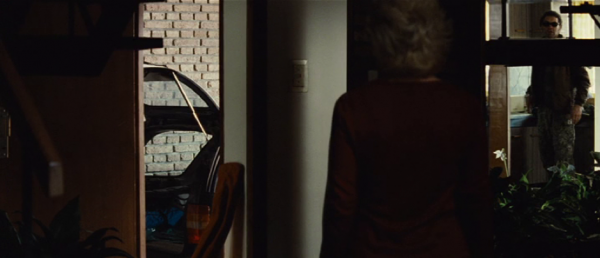
The Headless Woman, (2008)
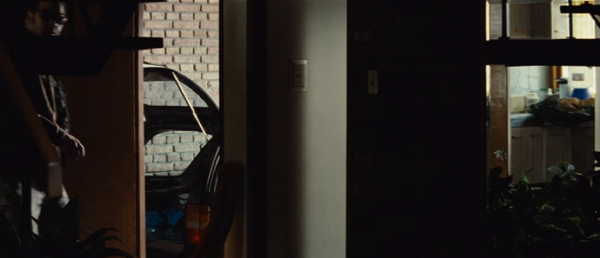
Strangeness in the familiar: in The Headless Woman, Martel estranges our perception of home, for example here by first showing Veronica’s husband on the right of the frame, before he comes out from the left side – we are forced into a double take and realise our first view of him was in a mirror reflection
In Martel’s cinema, then, the home means family and shelter, but also a suffocating cocoon, a place of exclusion, space and place at the same time, a dwelling where multiple perspectives co-exist, where images and sounds must be paid close attention to, and where rigid boundaries can be blurred and looked at anew. All this is apposite for our Covid-19 era, in which spending more time at home has meant we too must look at the domestic differently. But while the homes in the Salta trilogy offer only an illusion of safety because all Martel’s characters only have a limited perspective on what is around them, Martel leaves it up to us, her hopefully alert and curious audience, to learn the lessons they cannot. We may take on the challenge of perceiving the home with a fresh sense of possibility and not be as blindsided as her characters.
About The Author
Jean-Baptiste de Vaulx has recently completed a PhD on the circulation and reception of world cinema at Royal Holloway, University of London and writes about cinema at the Cinescope blog: https://cine-scope.com/.